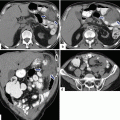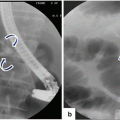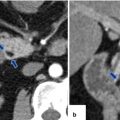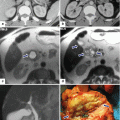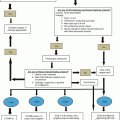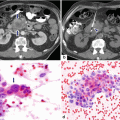Fig. 4.1
Diagram summarizing the physiology of the exocrine of the pancreas
Main components:
Alkaline fluid and electrolytes
Secreted mainly by pancreatic centroacinar cells after being stimulated by secretin.
Composed mainly of H2O and high concentrations of bicarbonate and electrolytes such as Na+, Cl−, and K+.
The main role is to neutralize the luminal acid of the intestine creating an adequate environment for the action of digestive enzymes.
Concentration of bicarbonate increases with increased pancreatic juice flow, as Cl− concentration decreases.
Concentration of Na+ and K+ remains constant irrespective of the rate of pancreatic juice secretion.
Practical Pearls
In cystic fibrosis, the pancreas is one of the most severely affected organs.
The defective gene CFTR (cystic fibrosis transmembrane conductance regulator gene) is involved in the regulation of chloride and bicarbonate secretion.
Inadequate secretion of anions reduces the flow of free water, causing protein precipitation and plugging of the pancreatic ducts.
Pancreatic enzymes
Exocrine pancreas mainly secretes four types of enzymes:
Amylases, lipases, nucleases, and proteases (Table 4.1)
These enzymes are mainly responsible for the digestion of protein, carbohydrates, and fat.
They are released by the action of cholecystokinin (CCK) and acetylcholine (Ach) on the acinar cells.
Table 4.1
Types of pancreatic enzymes
Zymogens | Active enzymes | ||
|---|---|---|---|
Proteases | Amylolytic enzymes | Lipases | Nucleases |
Trypsinogen Chymotrypsinogen (A and B) Proelastase Procarboxypeptidase A-B | Amylase | Lipase Esterase (sterol esterase, carboxylesterase) Phospholipase A2 | Deoxyribonuclease Ribonuclease |
These enzymes are released in their active form or as inactive precursors called zymogens.
Pancreatic proteases are released in the form of zymogens.
Once in the intestinal lumen, these zymogens are cleaved into their active form by activating enzymes.
Trypsinogen is cleaved into its active form, trypsin, by duodenal enteropeptidase. Once trypsin has been generated, it acts as a major enzyme for the activation of other zymogens (Table 4.2).
Table 4.2
Main pancreatic zymogens and active enzymes
Zymogen | Activating enzyme | Active enzyme |
|---|---|---|
Trypsinogen | Enterokinase | Trypsin |
Chymotrypsinogen | Trypsin | Chymotrypsin |
Procarboxypeptidase A-B | Trypsin | Carboxypeptidase |
Proelastase | Trypsin | Elastase |
Practical Pearls
Since the active enzymes are capable of digesting the cellular components of the pancreas, the secretion of zymogens is a safeguard against the autodigestion of the pancreas.
Acute pancreatitis is due to the inappropriate activation of proteolytic enzymes leading to inflammation and, in some cases, severe cell damage (pancreatic necrosis).
Chronic pancreatitis is preceded by multiple bouts of acute pancreatitis, resulting in permanent damage due to recurrent inflammation.
4.3.2 Main Regulators of the Exocrine Pancreas (Fig. 4.2)
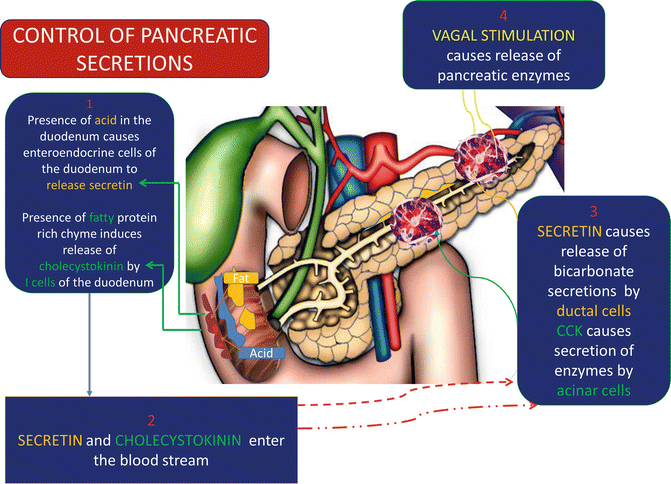
Fig. 4.2
Diagram summarizing the control of pancreatic secretion
Secretin
Produced by the S cells of the duodenum
Released in response to acidic chyme entering the duodenum
Most potent stimulator of alkaline fluid by acting on the ductal cells
Promotes the secretion of alkaline rich mucus by Brunner glands
Potentiates the effect of CCK
Cholecystokinin (CCK)
Secreted by the I cells of the duodenum
Released in response to lipids, small peptides, and amino acids entering the duodenum
Stimulates the release of pancreatic enzymes by the acinar cells
Other actions include contraction of the gallbladder and relaxation of the sphincter of Oddi, increased tension of the pyloric sphincter and delayed gastric emptying
Increases the effect of secretin
Acetylcholine (Ach)
Secreted by parasympathetic fibers of the vagus nerve
Released in response to acidic chyme, small peptides, amino acids, and lipids in the intestinal lumen
Stimulates the secretion of pancreatic enzymes and alkaline fluid
Increases the effect of secretin
Peptide YY (PYY)
Secreted by the L cells of the ileum and colon in response to fat entering the distal small intestine
Suppresses the secretion of the exocrine pancreas by acting on inhibitory neural pathways and decreasing pancreatic blood flow
Inhibits gastric secretion, increasing the time nutrients spend in the distal small bowel and colon
4.3.3 Secretion Patterns of the Exocrine Pancreas
Fasting period (interdigestive period)
Basal release of low levels of pancreatic enzymes and low levels of bicarbonate occur during the fasting state.
Rate of secretion varies and coincides with the cyclic motor activity of the intestines.
During this period, the main mediators are Ach and CCK.
Digestive period
Get Clinical Tree app for offline access
Characterized by a significant rise in the release of pancreatic secretions
Divided into three phases: cephalic, gastric, and intestinal
Phase I: Cephalic phase (20–25 % of secretory response)
▫Rapid phase triggered by sight, smell, taste, and the action of eating food
▫Characterized by a low-volume secretion with high levels of pancreatic enzymes
▫Mediated by the action of Ach through parasympathetic pathways
Phase II: Gastric phase (10 % of secretory response)
▫ Stimulated by the presence of food distending the stomach
Stay updated, free articles. Join our Telegram channel

Full access? Get Clinical Tree



